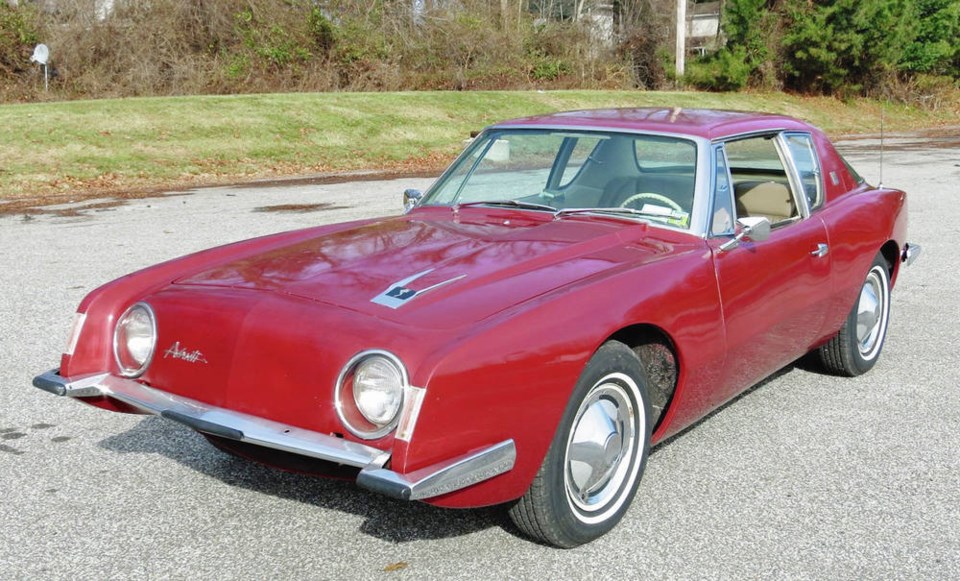When the Studebaker Avanti was announced in 1962 Studebaker history already dated back 110 years to 1852. It began when Clem and Henry Studebaker opened a blacksmith/wagon shop in South Bend, Indiana. They added cars in 1902 starting with an electric, and then a gasoline model in 1904. Electrics were discontinued in 1912 and horse-drawn vehicles soon after.
Just as its non-powered vehicles had, Studebaker cars developed a sound reputation. It survived the 1930s Depression, albeit after a brush with receivership. Following the Second World War Studebaker was the first established American manufacturer with a new post-war model, the sensational 1947 “coming-or-going” Raymond Loewy design.
The 1950s were difficult for non-Big Three (General Motors, Ford and Chrysler) automakers. After a sales flourish until the end of the post-war sellers’ market, relentless competition drove smaller companies Kaiser-Frazer, Crosley and Willys-Overland out of the market. It forced the 1954 amalgamation of Nash and Hudson into American Motors Corp.,
It also caused Studebaker to join Packard as Studebaker-Packard Corp. in 1954. Studebaker’s designs prevailed and “real” Packards disappeared in 1956 followed by Packard-badged “Packabakers” in 1958.
In spite of its new compact Lark model, Studebaker was still struggling and in 1961 a dynamic new president Sherwood Egbert was recruited from chain saw manufacturer McCulloch.
To revitalize Studebaker, Egbert wanted an image car. He turned to post-war hero Loewy, creator of those groundbreaking 1947 Studebakers and low silhouette 1953 Starliner/Starlight coupes, later the Hawk series. Loewy agreed to design an all-new Studebaker, but only if given a completely free hand.
Granted full autonomy, Loewy and associates worked secretly in Palm Springs, California and produced a full-size clay model within five weeks. It was dramatically different from anything seen before, even Studebaker’s big styling leap in 1947.
Called the Avanti - Italian for forward - the four-passenger, two-door grand touring’s hood dipped down to a slender bumper. Blade-like front fenders extended ahead of the hood flanking two round, glass-covered headlamps. There was no grille; cooling air entered under the bumper, and there was an asymmetrical hood bulge in front of the driver.
Little chrome was used and the concave flanks had “Coke bottle design.” Curved side glass, large rear window and high tail with an abrupt drop-off gave a definite wedge profile. Small taillights wrapped around the rear fenders and wide C-pillars concealed a built-in roll bar. The Avanti was all curves and arcs - not a straight line anywhere.
The front seats were comfortable buckets and the full set of round instruments included a tachometer and manifold pressure gauge. Overhead switches gave the cockpit aircraft like ambiance.
It was the dramatically daring styling statement Egbert wanted. To save time and money a fibreglass body was used mounted on a reinforced 2,769 mm (109 in.) wheelbase Studebaker Lark convertible chassis with stiffer springs and anti-roll bars. Brakes were rear drums and Dunlop front discs, America’s first production car caliper discs since the 1949 Crosley.
Molded Fiber Glass Products of Ashtabula, Ohio, builder of the Chevrolet Corvette, got the body contract. The Avanti had an ungraded version of Studebaker’s 4.7 litre (289 cu on.) 240 horsepower overhead valve V-8. With the optional Paxton-McCulloch centrifugal supercharger it developed an estimated 275 horsepower. Transmissions were three- and four-speed manuals and three-speed automatic.
Road & Track (10/62) timed a supercharged 3400 lb (1542 kg) four-speed Avanti to 60 mph (97 km/h) in 7.3 second, aided by a low 4.09:1 axle ratio. While good for acceleration this ratio limited top speed to 117 mph (188 km/h). Handling was judged mediocre.
Andy Granatelli, later of STP and Indianapolis fame, took three supercharged “R-3” Avantis (there were progressively tuned R-1 to R-5 versions) with 4.9 litre engines to Utah’s Bonneville Salt Flats in August, 1962. He broke 12 stock car speed records, including the flying mile at 168.15 mph (271 km/h).
Although the Avanti was introduced in 1962, fibreglass body difficulties delayed production until 1963. Body production was finally moved to South Bend, and this delay plus Studebaker’s precarious financial condition kept Avanti sales to only 3834 1963 models. This shrank to just 809 ’64s, which were identical except for square headlamps.
The Avanti never reached its true potential due to a slow start and buyer awareness of Studebaker’s financial difficulty. Its Indiana operation closed late in 1963 and Studebaker production continued in Hamilton, Ontario until 1966. Avantis were not made in Canada.
After Avanti production ended in South Bend, Studebaker dealers Nate Altman and Leo Newman established Avanti Motor Corporation in 1964 to produce Avanti IIs. They sold the company in 1982 and it subsequently went through several resurrection attempts.
The Avanti was a brave attempt by a dying company to save itself. While it failed at that task, it did produce a daringly different car.



